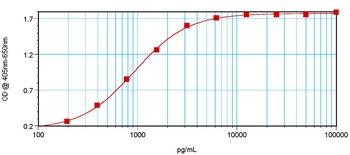Eotaxin 2 (CCL24) Mouse Monoclonal Antibody
Other products for "CCL24"
Specifications
| Product Data | |
| Applications | ELISA, IHC, WB |
| Recommended Dilution | ELISA: In a Sandwich ELISA (assuming 100 µl/well), a concentration of 2.0-4.0 µg/ml of this antibody will detect at least 80.0 pg/well of recombinant Human Eotaxin-2 when used with Biotin anti-Human Eotaxin-2 antibody (cat. AP01125BT) as the detection antibody at a concentration of approximately 1.0-2.0 µg/ml. Western Blot: To detect Human Eotaxin-2 by Western Blot analysis this antibody can be used at a concentration of 0.25-0.50 µg/ml. Used in conjunction with compatible secondary reagents the detection limit for recombinant Human Eotaxin-2 is 0.5-1.0 ng/lane, under non-reducing conditions. Immunohistochemistry on Paraffin Sections: 10.0 μg/ml with an overnight incubation at 4˚C. An HRP-labeled polymer detection system was used with a DAB chromogen. This antibody stained formalin-fixed, paraffin-embedded sections of human tonsil. Heat induced antigen retrieval with a pH 8.0 EDTA buffer is recommended. Optimal concentrations and conditions may vary. Protocol and staining provided by Dr. Lauren Binge, Laboratory of Prof. Charles Mackay, Monash Univeristy, Australia. |
| Reactivities | Human |
| Host | Mouse |
| Isotype | IgG1 |
| Clonality | Monoclonal |
| Immunogen | Highly pure (>98%) recombinant Human Eotaxin-2 |
| Specificity | This antibody detects Human Eotaxin-2. |
| Formulation | PBS without preservatives State: Azide Free State: Lyophilized (sterile filtered) IgG fraction |
| Reconstitution Method | Restore in sterile water to a concentration of 1.0 mg/ml. |
| Purification | Antigen Affinity Chromatography |
| Conjugation | Unconjugated |
| Storage | Lyophilized product is stable at room temperature for one month, and at -20°C for longer. Following reconstitution it should be stored at 2-8°C up to six weeks. Avoid repeated freezing and thawing. |
| Stability | Shelf life: one year from despatch. |
| Gene Name | C-C motif chemokine ligand 24 |
| Database Link | |
| Background | Eotaxin 2 is a member of the CC chemokine family, based on the presence of the CC motif and homology with other known CC chemokines. Eotaxin 2 cDNA encodes a 119 amino acid residue precursor protein with a 26 amino acid residue signal peptide that is cleaved to generate a mature protein predicted to contain 93 amino acid residues with an N glycosylation site. Mature human eotaxin 2 has a predicted molecular mass of approximately 10.6 kDa. Compared to other CC chemokines, eotaxin 2 exhibits 40 %, 42 %, and 39 % amino acid identity to MCP3, MIP1 alpha, and eotaxin, respectively. Human CC chemokine eotaxin 2 maps to chromosome 7q11.23. Both Eotaxin and eotaxin 2 activate and attract eosinophils and basophils. A receptor for human eotaxin has been identified and found to be the third numbered receptor in the C-C chemokine subfamily of receptors (CCR3. On eosinophils, the effects of eotaxin 2 is inhibited by an CCR3 antibody and cross-desensitized by eotaxin and MCP4, suggesting that all three CC chemokines act through CCR3. Eotaxin 2 mRNA is weakly expressed in activated monocytes and T lymphocytes. Recombinant eotaxin 2 induces chemotaxis of eosinophils, basophils, and resting T lymphocytes but not monocytes and activated T lymphocytes. Eotaxin 2 inhibits colony formation in myleloid progenitor cells. |
| Synonyms | C-C motif chemokine 24, Small-inducible cytokine A24, MPIF2, MPIF-2, SCYA24, CK-beta-6 |
| Note | Protocol: The following protocol used formalin-fixed paraffin-embedded human tonsil tissue. 1. Deparaffinize and rehydrate the tissue section. 2. Perform heat-induced antigen retrieval with 1mM EDTA pH 8.0 at 123˚C for 3 minutes in a pressure chamber. Wash the slide twice for three minutes each (50mM Tris-HCl pH 8.0, 150mM NaCl in distilled water). 3. Incubate the tissue section with 1% BSA/PBS block. 4. Incubate the tissue section overnight at 4˚C with Mouse Anti-Human Eotaxin-2 at 10.0 μg/mL. Wash the slide twice for three minutes each. 5. Incubate the tissue section with an HRP polymer kit according to the manufacturer's protocol. Wash the slide twice for three minutes each. 6. Incubate the tissue section with the DAB chromogen. 7. Counterstain the tissue section with hematoxylin. 8. Coverslip the sections with mounting medium. Protocol and staining provided by Dr. Lauren Binge, Laboratory of Prof. Charles Mackay, Monash University, Australia. |
| Reference Data | |
Documents
| Product Manuals |
| FAQs |
| SDS |
{0} Product Review(s)
0 Product Review(s)
Submit review
Be the first one to submit a review
Product Citations
*Delivery time may vary from web posted schedule. Occasional delays may occur due to unforeseen
complexities in the preparation of your product. International customers may expect an additional 1-2 weeks
in shipping.






























































































































































































































































 Germany
Germany
 Japan
Japan
 United Kingdom
United Kingdom
 China
China




